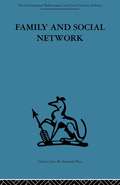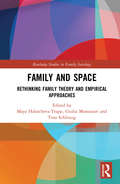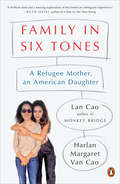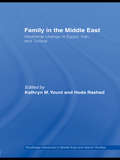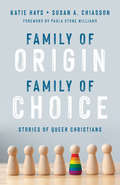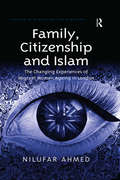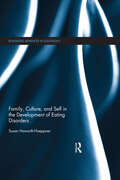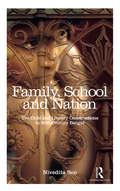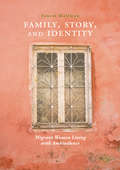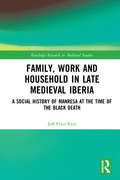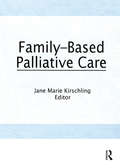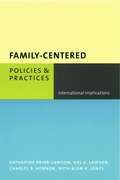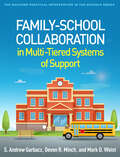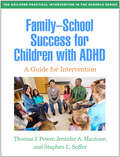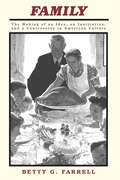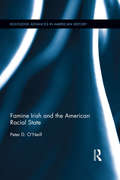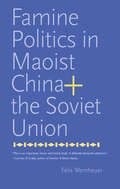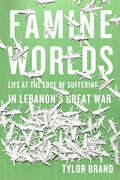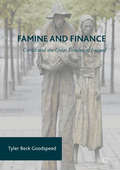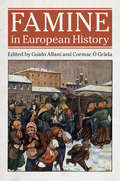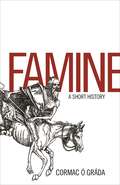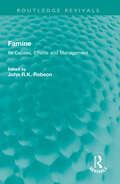- Table View
- List View
Family and Social Network: Roles, Norms and External Relationships in Ordinary Urban Families (Reprint Series In Social Sciences)
by Elizabeth BottTavistock Press was established as a co-operative venture between the Tavistock Institute and Routledge & Kegan Paul (RKP) in the 1950s to produce a series of major contributions across the social sciences. This volume is part of a 2001 reissue of a selection of those important works which have since gone out of print, or are difficult to locate. Published by Routledge, 112 volumes in total are being brought together under the name The International Behavioural and Social Sciences Library: Classics from the Tavistock Press. Reproduced here in facsimile, this volume was originally published in 1957 and is available individually. The collection is also available in a number of themed mini-sets of between 5 and 13 volumes, or as a complete collection.
Family and Space: Rethinking Family Theory and Empirical Approaches (Routledge Studies in Family Sociology)
by Maya Halatcheva-Trapp Giulia Montanari Tino SchlinzigWhile the ‘spatial turn’ within the social sciences has already nurtured a broad discussion of the relation between society and space, little attention has so far been paid to the question of what we can learn about families when exploring space in its different facets. This book brings together international authors from the fields of sociology, human geography, and anthropology to support the development of space-sensitive and de-territorialised perspectives on the family that reach beyond classical concepts such as the ‘household’ or the ‘nuclear family’. With close attention to the implications of differing relations to space for the social fabric of families, it presents studies of theoretical, methodological, and empirical aspects of late-modern family life. Examining the meaning of absence and presence for parenting, the aesthetic, and sensual dimensions of everyday family life, and its digital and media-related features aspects, Family and Space considers the value of a range of approaches to researching the spatial elements of family life, including ethnographic accounts, interviews, group discussions, mobile methods, and network analyses.
Family in Six Tones: A Refugee Mother, an American Daughter
by Lan Cao Harlan Margaret Van Cao"A brilliant duet and a moving exploration of the American immigrant experience."--Ruth Ozeki, author of A Tale for the Time BeingA dual first-person memoir by the acclaimed Vietnamese-American novelist and her thoroughly American teenage daughterIn 1975, thirteen-year-old Lan Cao boarded an airplane in Saigon and got off in a world where she faced hosts she had not met before, a language she didn't speak, and food she didn't recognize, with the faint hope that she would be able to go home soon. Lan fought her way through confusion, and racism, to become a successful lawyer and novelist. Four decades later, she faced the biggest challenge in her life: raising her daughter Harlan--half Vietnamese by birth and 100 percent American teenager by inclination. In their lyrical joint memoir, told in alternating voices, mother and daughter cross ages and ethnicities to tackle the hardest questions about assimilation, aspiration, and family.Lan wrestles with her identities as not merely an immigrant but a refugee from an unpopular war. She has bigoted teachers who undermine her in the classroom and tormenting inner demons, but she does achieve--either despite or because of the work ethic and tight support of a traditional Vietnamese family struggling to get by in a small American town. Lan has ambitions, for herself, and for her daughter, but even as an adult feels tentative about her place in her adoptive country, and ventures through motherhood as if it is a foreign landscape.Reflecting and refracting her mother's narrative, Harlan fiercely describes the rites of passage of childhood and adolescence, filtered through the aftereffects of her family's history of war, tragedy, and migration. Harlan's struggle to make friends in high school challenges her mother to step back and let her daughter find her own way.Family in Six Tones speaks both to the unique struggles of refugees and to the universal tug-of-war between mothers and daughters. The journey of an immigrant--away from war and loss toward peace and a new life--and the journey of a mother raising a child to be secure and happy are both steep paths filled with detours and stumbling blocks. Through explosive fights and painful setbacks, mother and daughter search for a way to accept the past and face the future together.
Family in the Middle East: Ideational change in Egypt, Iran and Tunisia (Routledge Advances in Middle East and Islamic Studies #15)
by Kathryn M. Yount Hoda RashadThis book examines, in comparative perspective, the different ideals about family and society and how they have impacted on real family life across a number of countries in the Middle East.
Family of Origin, Family of Choice: Stories of Queer Christians
by Katie Hays Susan A. ChiassonFirst-person testimonies from LGBTQ+ Christians about coming out and navigating their family dynamicsWhat happens in a family when one member comes out? How does LGBTQ+ identity affect relationships with parents and grandparents, siblings and cousins? What does Christian love require and make possible for families moving forward together? A social scientist and a pastor, both from Galileo Church on the outskirts of Fort Worth, Texas, asked their LGBTQ+ friends from church to help them understand how they navigate relationships with their affirming, non-affirming, and affirming-ish families of origin, even as they also find belonging in other families of choice. The resulting stories, crafted from interviews with fifteen queer Christians and family members, kept anonymous at their request, are as varied as the colors of the rainbow. Over the years, some grew closer to their families of origin; others grew more distant. Some were surprised by the hardness of heart they encountered; others were amazed by the breadth of their family&’s love. Most all describe a trajectory, a journey, from the coming-out moment till now and beyond, as their families of origin, like all families, remain a work in progress.
Family, Citizenship and Islam: The Changing Experiences of Migrant Women Ageing in London (Studies in Migration and Diaspora)
by Nilufar AhmedA longitudinal, intersectional study of migrant women, this book examines the lives of first generation Bangladeshi migrants to the UK, considering the dynamic relationship between people and place. Shedding new light on a migrant population about which little is known, the author explores the experiences of women who left rural homes to live in London, speaking no English, with no experience of local customs and having to adjust to what would now be dramatically shrunken family sizes, within which they would act as bearers of culture and tradition. Based on research spanning a decade Family, Citizenship and Islam draws on qualitative interviews with over 100 women and examines questions of identity, belonging, citizenship and Britishness, religion, ageing, care, and the family. With attention to the fluidity of the experiences of the first generation of migration women, the book offers an alternative to much ethnographic research, which often offers only a 'snapshot' of a particular minority or migrant group as fixed and preserved in time. As such, Family, Citizenship and Islam will appeal to scholars of sociology, geography and anthropology with interests in migration and diaspora, citizenship, gender, religion, family and the lifecourse, and the ways in which these different aspects of a person's life come together to shape lived experience.
Family, Culture, and Self in the Development of Eating Disorders (Routledge Advances in Sociology)
by Susan Haworth-HoeppnerThis book takes a unique approach to the examination of the eating disorder, anorexia nervosa (and bulimia). White, middle-class, heterosexual women share their insights into the emergence of their illnesses through detailed interviews that consider perceptions of the role of family, the influence of cultural messages regarding thinness and beauty, the agency these women exert in the use of weight control to cope with life’s stressors, the meaning they attach to their eating disorders and how these issues together perpetuate their disease. The book uses a Symbolic Interactionist framework and a grounded theory approach to examine the narratives which emerge from these women’s stories. Themes of family, culture, and self arise in their narratives; these form the theoretical underpinnings for this book, and combine to shape the comprehensive model of eating disorders that emerges from this study. Haworth-Hoeppner’s book will appeal to researchers and advanced students of sociology, women’s studies, family studies, social psychology, and gender studies.
Family, School and Nation: The Child and Literary Constructions in 20th-Century Bengal
by Nivedita SenThis seminal work examines the concurrence of childhood rebellion and conformity in Bengali literary texts (including adult texts), a pertinent yet unexplored area, making it a first of its kind. It is a study of the voice of child protagonists across children’s and adult literature in Bengali vis-à-vis the institutions of family, the education system, and the nationalist movement in the ninenteenth and twentieth centuries.
Family, Story, and Identity: Migrant Women Living with Ambivalence
by Senem MallmanHow do second-generation migrant women connect with their cultural heritage when ethnic ties have been weak or absent for most of their lives? Family, Story and Identity presents the life stories of twenty women of various ethnicities, analysis of published autobiographies, as well as autoethnographic accounts of the author’s experiences, to show how stories connect adult children of immigrants with their cultural heritage. The collecting of stories comes in various forms and can include brief visits to ancestral homelands, documenting family histories and genealogies, and gathering stories, folktales, and recipes. Senem Mallman found that, as adults, many children of immigrants actively seek out family histories and stories in order to connect with their cultural heritage and with their parents, and to pass this knowledge on to their own children. She argues that seeking out stories enables the second-generation to find a place within their family narrative. This pursuit of stories leads them toward developing new perspectives about their culture, family and life in Australia, and new ways of living with their cultural ambivalence.
Family, Work, and Household in Late Medieval Iberia: A Social History of Manresa at the Time of the Black Death (Routledge Research in Medieval Studies #13)
by Jeff Fynn-PaulFamily, Work, and Household presents the social and occupational life of a late medieval Iberian town in rich, unprecedented detail. The book combines a diachronic study of two regionally prominent families—one knightly and one mercantile—with a detailed cross-sectional urban study of household and occupation. The town in question is the market town and administrative centre of Manresa in Catalonia, whose exceptional archives make such a study possible. For the diachronic studies, Fynn-Paul relied upon the fact that Manresan archives preserve scores of individual family notarial registers, and the cross-sectional study was made possible by the Liber Manifesti of 1408, a cadastral survey which details the property holdings of individual householders to an unusually thorough degree. In these pages, the economic and social strategies of many individuals, including both knights and burghers, come to light over the course of several generations. The Black Death and its aftermath play a prominent role in changing the outlook of many social actors. Other chapters detail the socioeconomic topography of the town, and examine occupational hierarchies, for such groups as rentiers, merchants, leatherworkers, cloth workers, women householders, and the poor.
Family-Based Palliative Care
by Jane Marie KirschlingLearn to interact with families in ways that promote family functioning when a family member is dying. Family-Based Palliative Care is an insightful book that aims to increase professionals’understanding of the family as client. Authoritative contributors who are experienced in working with the terminally ill present the most current theory, practice, and research related to family-based care of hospice patients. Each readable chapter includes a wealth of information that can be applied to health care settings in which holistic care is a priority. The first chapter presents a conceptual framework for caring for families of the terminally ill as well as clinical examples that are used to illustrate the application of the framework in practice. Experts describe four research studies--two qualitative studies that examine sources of stress for caregivers and identify the resources used by families to manage at home; a methodological study that explores the positive and negative aspects of family caregiving; and a case study that evaluates a hospice staff’s efforts in providing family- based care.Because little research has been done with family caregivers of terminally ill hospice patients, Family-Based Palliative Care will be essential reading for nurses, social workers, hospice staff, and other professionals whose job it is to care for the dying and their families.
Family-Centered Policies and Practices: International Implications
by Hal A. Lawson Charles B. Hennon Alan R. Jones Briar-Lawson KatharineBy including a conceptual framework as well as practice components, the authors offer an original multimodal approach toward understanding family-centered policy practice from an international perspective. It provides grassroots strategies for activists and practical guides for both students and practitioners and includes cutting-edge interpretations of the impact of globalization on families, social workers, and other helping professionals and advocates.
Family-Centered Policies and Practices: International Implications
by Katharine Briar-Lawson Hal Lawson Charles HennonAnalyzing the critical juncture of family-centered policy and practice, this book places the universal institution of the family in a global context. By including a conceptual framework as well as practice components, the authors offer an original multimodal approach toward understanding family-centered policy practice from an international perspective. It provides grassroots strategies for activists and practical guides for both students and practitioners and includes cutting-edge interpretations of the impact of globalization on families, social workers, and other helping professionals and advocates.
Family-Centered Services in Residential Treatment: New Approaches for Group Care
by John Y PowellAdopt a more effective approach to temporary and long-term residential care! Presenting the voices of staff, parents, and residents, Family-Centered Services in Residential Treatment: New Approaches for Group Care examines the changes and challenges of residential care from the old-fashioned orphanage to the modern group-care home. These thoughtful essays offer suggestions and methods to provide more effective services in temporary and long-term settings. Containing case studies, personal experiences, and professional insights about the potentials and limitations of residential care, this reliable resource will help you develop improved services for youths and their families. Family-Centered Services in Residential Treatment presents fresh evaluations of new and old techniques as well as ideas for meeting individual needs. By building connections among parents, youths, and staff, you can develop more successful treatment programs and encourage stronger family ties even when children are best served by long-term residential care.Family-Centered Services in Residential Treatment addresses the crucial questions of residential care, including:how can staff ease children's transitions into and out of residential care? what do parents of emotionally disturbed youth need from the staff and professionals in a residential care setting? what was right--and wrong--about the old-fashioned orphanage? Could such an institution work today? how does the transition to the teamwork approach affect staff members? when is residential care most beneficial to children? what kind of care is appropriate for AIDS orphans?Family-Centered Services in Residential Treatment will help psychologists, therapists, and social workers unite theory and practice to create a family-oriented environment for troubled clients.
Family-School Collaboration in Multi-Tiered Systems of Support (The Guilford Practical Intervention in the Schools Series)
by Mark D. Weist S. Andrew Garbacz Devon R. MinchFamily–school collaboration has proven benefits for students&’ social, emotional, behavioral, and academic functioning, yet many schools struggle to create and sustain effective partnerships with families. This timely resource provides an equity-focused, culturally responsive framework for embedding family collaboration within multi-tiered systems of support (MTSS). The field-leading authors present best practices for involving families in data-based decision making and problem solving at Tiers 1, 2, and 3. Chapters from guest experts address key issues in implementation, including detailed case studies. In a convenient large-size format, the book provides implementation guides, practitioner vignettes, candid parent quotations, and reproducible checklists, forms, and sample scripts that can be downloaded and printed. This book is in The Guilford Practical Intervention in the Schools Series, edited by Sandra M. Chafouleas.
Family-School Success for Children with ADHD: A Guide for Intervention (The Guilford Practical Intervention in the Schools Series)
by Thomas J. Power Jennifer A. Mautone Stephen L. SofferDistilling decades of research, this practical manual presents an innovative intervention for families of 6- to 10-year-olds (grades 1–5) with attention-deficit/hyperactivity disorder (ADHD). Family–School Success (FSS) focuses on improving children's behavior and academic performance by strengthening parent–child, teacher–student, and family–school relationships. Detailed guidelines are provided for implementing FSS with parent groups or individual families, including how to involve children in groups and collaborate with teachers. The authors discuss ways to deliver FSS effectively in school- and clinic-based settings, private practice, and primary care. In a convenient large-size format, the book features dozens of reproducible parent handouts and worksheets, assessment tools, and fidelity checklists, which can also be downloaded and printed. This book is in The Guilford Practical Intervention in the Schools Series, edited by Sandra M. Chafouleas.
Family: The Making Of An Idea, An Institution, And A Controversy In American Culture (Suny Series In The Sociology Of Work And Organizations Ser.)
by Betty FarrellAssumptions about the family of the past pervade the expectations we bring to our personal interactions and shape the way we think about and study the family as a social institution. Most often, undergraduate courses in family sociology have a ?marriage and family? focus, which emphasizes the dynamics of interpersonal relations and contemporary family roles. Similarly, sociological concerns focus on the present and the future of family life, with little attention to the past except as it provides a contrast with current experience.The research conducted by family historians over the past three decades challenges, modifies, and ultimately enriches sociological understandings about American family life today. By looking closely at the historical record, the author is able to debunk certain myths, such as the belief that the ?ideal? family (male breadwinner and female domestic manager) has been historically prevalent; that the ?traditional? family has been disintegrating in recent years; that the presumed breakdown of the family has left children more vulnerable than in the past. Drawing on and integrating this literature, then, allows students to develop new perspectives on contemporary social issues and reorients the kinds of questions sociologists bring to the study of family structures and processes.
Famine Irish and the American Racial State (Routledge Advances in American History)
by Peter D. O'NeillAccounts of Irish racialization in the United States have tended to stress Irish difference. Famine Irish and the American Racial State takes a different stance. This interdisciplinary, transnational work uses an array of cultural artifacts, including novels, plays, songs, cartoons, government reports, laws, sermons, memoirs, and how-to manuals, to make its case. It challenges the claim that the Irish "became white" in the United States, showing that the claim fails to take into full account the legal position of the Irish in the nineteenth-century US state – a state that deemed the Irish "white" upon arrival. The Irish thus not only fitted into the US racial state; they helped to form it. Till now, little heed has been paid to the state’s role in the Americanization of the Irish or to the Irish role in the development of US state institutions. Distinguishing American citizenship from American nationality, this volume journeys to California to analyze the means by which the Irish gained acceptance in both categories, at the expense of the Chinese. Along the way, it contests ideas that have taken hold within American studies. One is the notion that the Roman Catholic Church operated outside of the power structure of the nineteenth-century United States. On the contrary, Famine Irish and the American Racial State argues, the Irish-led corporate Catholic Church became deeply imbricated in US state structures. Its final chapter discusses a radical, transnational, Irish tradition that offers a glimpse at a postnational future.
Famine Politics in Maoist China and the Soviet Union
by Felix WemheuerDuring the twentieth century, 80 percent of all famine victims worldwide died in China and the Soviet Union. In this rigorous and thoughtful study, Felix Wemheuer analyzes the historical and political roots of these socialist-era famines, in which overambitious industrial programs endorsed by Stalin and Mao Zedong created greater disasters than those suffered under prerevolutionary regimes. Focusing on famine as a political tool, Wemheuer systematically exposes how conflicts about food among peasants, urban populations, and the socialist state resulted in the starvation death of millions. A major contribution to Chinese and Soviet history, this provocative analysis examines the long-term effects of the great famines on the relationship between the state and its citizens and argues that the lessons governments learned from the catastrophes enabled them to overcome famine in their later decades of rule.
Famine Worlds: Life at the Edge of Suffering in Lebanon’s Great War
by Tylor BrandWorld War I was a catastrophe for the lands that would become Lebanon. With war came famine, and with famine came unspeakable suffering, starvation, and mass death. For nearly four years the deadly crisis reshaped society, killing untold thousands and transforming how people lived, how they interacted, and even how they saw the world around them. Famine Worlds peers out at the famine through their eyes, from the wealthy merchants and the dwindling middle classes, to those perishing in the streets. Tylor Brand draws on memoirs, diaries, and correspondence to explore how people negotiated the famine and its traumas. Many observers depicted society in collapse—the starving poor became wretched victims and the well-fed became villains or heroes for the judgment of their peers. He shows how individual struggles had social effects. The famine altered beliefs and behaviors, and those in turn influenced social relationships, policies, and even the historical memory of generations to come. More than simply a chronicle of the Great Famine, however, Famine Worlds offers a profound meditation on what it means to live through such collective trauma, and how doing so shapes the character of a society. Brand shows that there are consequences to living amid omnipresent suffering and death. A crisis like the Great Famine is transformative in ways we cannot comprehend. It not only reshapes the lives and social worlds of those who suffer, it creates a particular rationality that touches the most fundamental parts of our being, even down to the ways we view and interact with each other. We often assume that if we were thrust into historic calamity that we would continue to behave compassionately. Famine Worlds questions such confidence, providing a lesson that could not be more timely.
Famine and Finance
by Tyler Beck GoodspeedThis book utilizes archival data to examine how access to microfinance credit played an important role in facilitating adjustment to blight during the Great Famine of Ireland. Chapters in the book discuss how Irish farmers adjusted to the major environmental shock, the role of credit institutions and their responses to the potato blight, and the effects of the Great Famine on Irish microfinance institutions themselves. The author argues that the worst affected districts with a microfinance fund experienced substantially smaller population declines and larger increases in buffer livestock during the famine than those districts without a fund. The potentially limited capacity of credit access to mitigate the effects of a major environmental shock on the poorest, most vulnerable borrowers is also a key topic of discussion. Famine and Finance draws on a wealth of archival data to construct an index of blight severity at local level and establish the adjustments made in different districts in response to the Great Famine of Ireland.
Famine and Scarcity in Late Medieval and Early Modern England
by Buchanan SharpSurveying government and crowd responses ranging from the late Middle Ages through to the early modern era, Buchanan Sharp's illuminating study examines how the English government responded to one of the most intractable problems of the period: famine and scarcity. The book provides a comprehensive account of famine relief in the late Middle Ages and evaluates the extent to which traditional market regulations enforced by thirteenth-century kings helped shape future responses to famine and scarcity in the sixteenth century. Analysing some of the oldest surviving archival evidence of public response to famine, Sharp reveals that food riots in England occurred as early as 1347, almost two centuries earlier than was previously thought. Charting the policies, public reactions and royal regulations to grain shortage, Sharp provides a fascinating contribution to our understanding of the social, economic, cultural and political make-up of medieval and early modern England.
Famine in European History
by Guido Alfani Gráda Cormac ÓThis is the first systematic study of famines in all parts of Europe from the Middle Ages until the present. In case studies ranging from Scandinavia and Italy to Ireland and Russia, leading scholars compare the characteristics, consequences and causes of famine. The famines they describe differ greatly in size, duration and context; in many cases the damage wrought by poor harvests was confounded by war. The roles of human action, malfunctioning markets and poor relief are a recurring theme. The chapters also take full account of demographic, institutional, economic, social and cultural aspects, providing a wealth of new information which is organized and analysed within a comparative framework. Famine in European History represents a significant new contribution to demographic history, and will be of interest to all those who want to discover more about famines - truly horrific events which, for centuries, have been a recurring curse for the Europeans.
Famine: A Short History
by Cormac Ó GrádaFamine remains one of the worst calamities that can befall a society. Mass starvation--whether it is inflicted by drought or engineered by misguided or genocidal economic policies--devastates families, weakens the social fabric, and undermines political stability. Cormac Ó Gráda, the acclaimed author who chronicled the tragic Irish famine in books like Black '47 and Beyond, here traces the complete history of famine from the earliest records to today. Combining powerful storytelling with the latest evidence from economics and history, Ó Gráda explores the causes and profound consequences of famine over the past five millennia, from ancient Egypt to the killing fields of 1970s Cambodia, from the Great Famine of fourteenth-century Europe to the famine in Niger in 2005. He enriches our understanding of the most crucial and far-reaching aspects of famine, including the roles that population pressure, public policy, and human agency play in causing famine; how food markets can mitigate famine or make it worse; famine's long-term demographic consequences; and the successes and failures of globalized disaster relief. Ó Gráda demonstrates the central role famine has played in the economic and political histories of places as different as Ukraine under Stalin, 1940s Bengal, and Mao's China. And he examines the prospects of a world free of famine. This is the most comprehensive history of famine available, and is required reading for anyone concerned with issues of economic development and world poverty.
Famine: Its Causes, Effects and Management (Routledge Revivals)
by John R.K. RobsonIn Famine (1981), a collection of essays by experts from the developing world and advanced agricultural societies, the authors share their ecological perspectives and provide an insight into the multiple causes of famine. They examine the fact that the main cause of famine is more likely to be as a result of human actions, rather than the vagaries of climate, and look at whether planned intervention by governments and relief agencies may compound the problems already existing.
